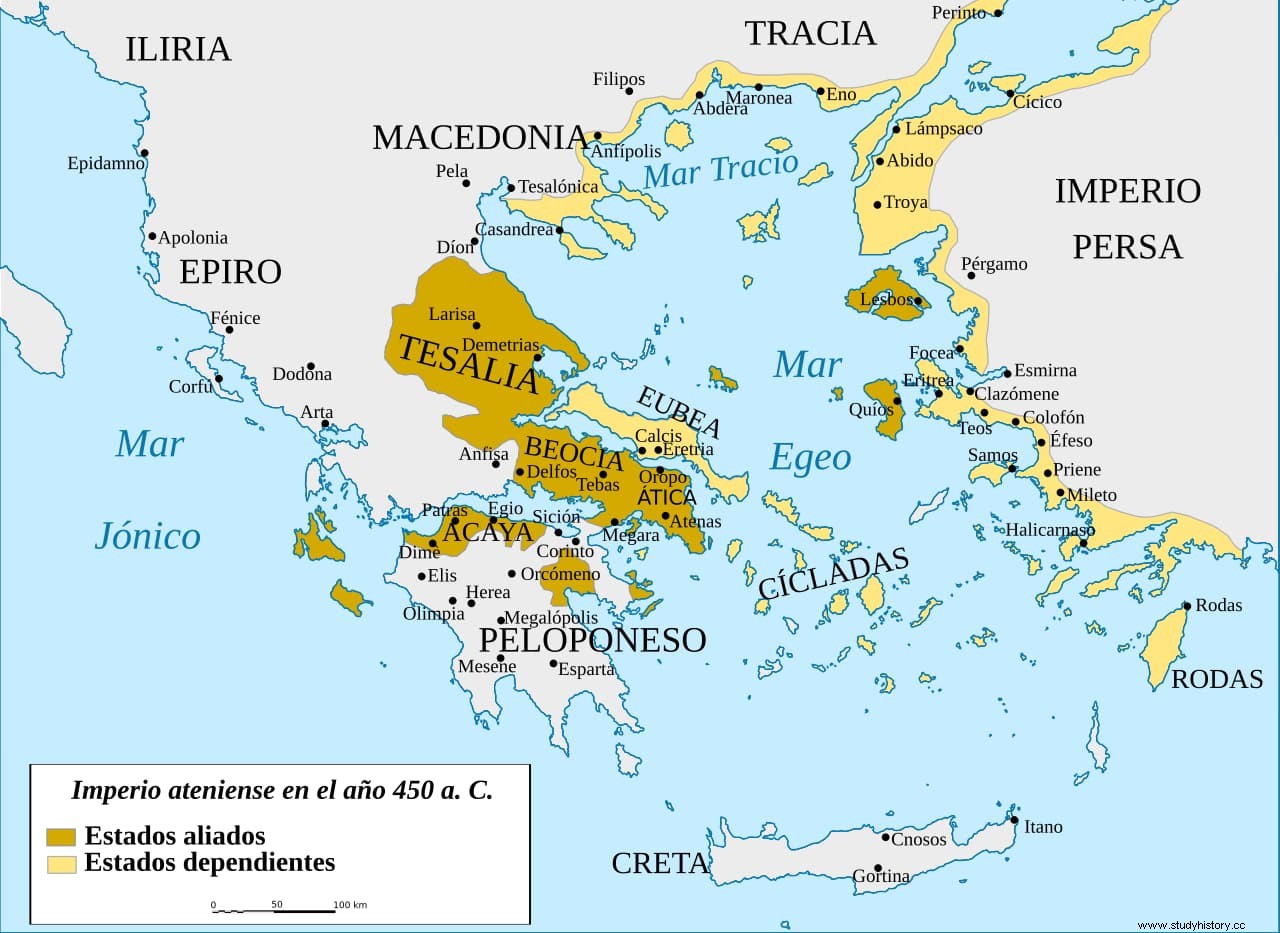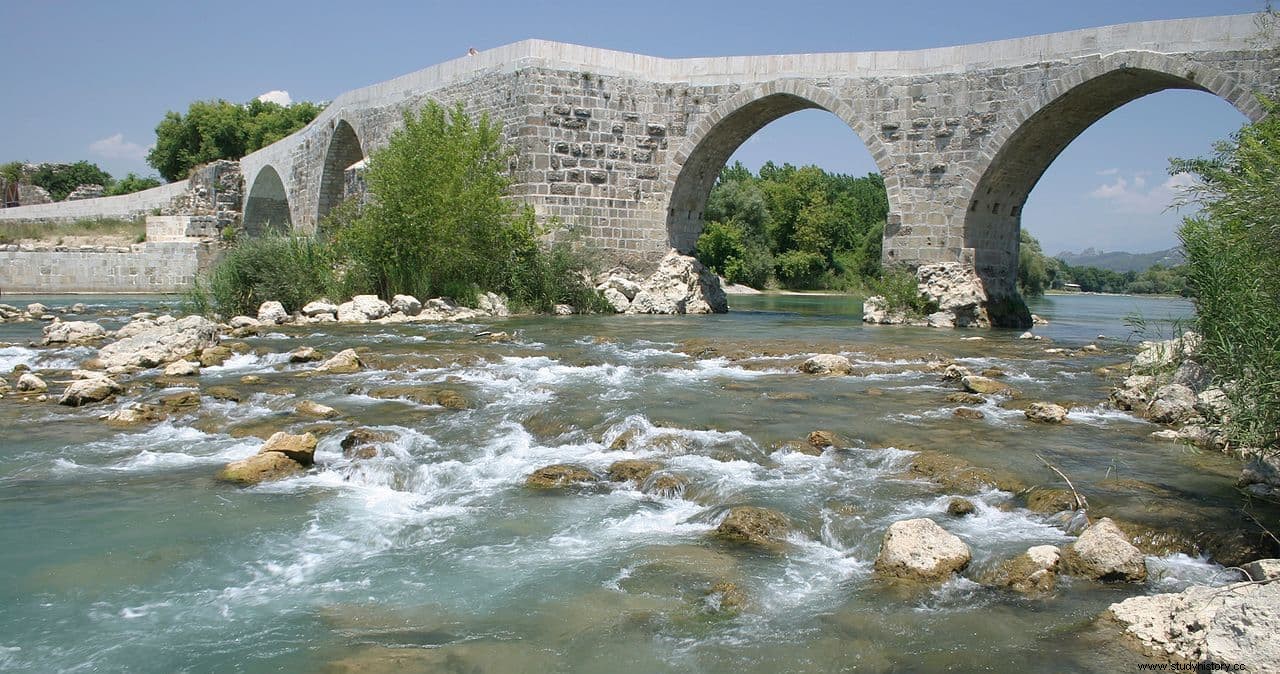The Persian Wars pitted the Greeks against the Persians for fifty-nine years in the second half of the 5th century BC. for the control of the so-called Asiatic Greece, the western part of the Anatolian peninsula (Ionia, Eólida and Dórida) and its islands, all of it of Hellenic culture. The Persian Empire failed in the first two conflicts after losing battles such as Marathon, Salamina or Plataea, but its human and economic potential was enormous, so, in 467 BC, King Artaxerxes wanted to finish what his father Xerxes and his grandfather Dario I had started... and crashed again, this time at the Battle of the Eurymedon.
Everything took place in a special context, a post-war period that took place after the Second Medical War, which Thucydides called Pentecontetia (due to its duration of fifty years), which would last until 433 BC, when the Peloponnesian War broke out. It was characterized by the primacy of Athens at the head of the Attic-Delic League (name derived from having its center on the island of Delos), which was a coalition of polis from Attica that also brought together Boeotia, Achaia, Thessaly, the islands of Lesvos, Rhodes and Chios, in addition to having under its influence Euboea, Chalcidica, the Cyclades, the coasts of the Thracian Sea and the regions of the coast of Asia Minor mentioned before.
It was a simachia -the traditional military alliance- based on maritime power, given the loss of hegemony of Sparta, which according to Thucydides «no longer wanted to bear the burden of the war against Persia and, therefore, willingly agreed for capable Athenians to exercise command" . The members contributed ships, men, money and equipment for the campaigns, giving leadership to the Athenians, although they all had a representative in the synedrion or council, which had a confederal character. It was a replica of the similar coalition led by Sparta, the Peloponnesian League.

In fact, during the Second Persian War, the two great Greek blocs had united in the Panhellenic League to face the common enemy, which was, obviously, Persia. It had been scalded by its invasion attempts but retained a formidable force. however, at the end of the war the Spartans left the league to re-establish the Peloponnesian league and this prompted Athens to do the same. So, once again, Greece was disunited again and Artaxerxes saw in it the great opportunity.
Moreover, despite being the architect of the victory at Salamis and the promoter of the ambitious Athenian shipbuilding program (he built around twenty triremes a year), the strategos Themistocles had amassed so many enemies that he ended up ostracized. He first went to Argos, where the Spartans accused him of having been part of the betrayal of Pausanias; This was a general and regent, nephew of Leonidas, winner at Plataea but dismissed for his arrogance and despotism, which had led many cities to move away from Sparta and approach Athens (Pausanias ended up sentenced to death after establishing contacts with the Persians). Themistocles then fled from Greece to Asia Minor, putting himself in the service of Artaxerxes.

Actually, Themistocles had no chance to bring his military genius to his new lord because he predeceased him, probably between 471 and 470 BC. C. The position of strategos that he had in Athens was occupied by Cimón, son of Milcíades (the winner in the Battle of Marathon), who curiously had been close to Sparta (a kind of consul or representative of the interests of one polis in another) and, therefore, admirer of the Lacedaemonian political regime. But he had both noble and popular support, so he was forgiven those pro-Spartan dalliances that, after all, were the opposite of what his predecessor had promoted; he himself was one of those who voted in favor of the ostracism of Themistocles.
It is not known exactly when the Greek cities of Asia Minor joined the Delian League; it is estimated that around 478 B.C. It was something that the Persian empire was not willing to allow and began to assemble a large fleet in Aspendos, near the mouth of the Eurymedon River (about forty-five kilometers from today's Turkish Antalya). It is possible, however, that the Greeks began their own preparations in advance, which would make them the aggressors against the classical image, since Artaxerxes probably intended not another invasion but to subdue Ionia.
In any event, Cimon sailed with his fleet from Byzantium to the Strymonic Gulf, where he besieged Eyon, a Thracian city in Persian hands. Its Medo governor, Boges, defended it heroically and it was necessary to divert the course of the river Strymon towards the wall, to soften the ground that supported it and make it crumble. Once conquered and its inhabitants subjected to slavery, the next objective was the island of Sciro, key to securing the sea route between Piraeus and Chalcidice, since its fleet sailed to Cnidus and used its port as a starting point to seize various polis in the Anatolian region of Caria and Lycia, putting the Hellenic world on a war footing.
Next came the time to engage the Persian fleet assembled at Aspendus. Cimon sailed from Cnidus in command of two hundred triremes, built on Themistocles' model but reinforced by him by incorporating fourteen foot soldiers each, imitating what the Persians had done during the Second Persian War by carrying thirty on each ship. The ships provided by Chios went further and embarked forty, a dangerous figure because it could destabilize them. The fact is that this is how no less than five thousand hoplites were embarked, in what can probably be considered the first marine infantry in history.

The Greek fleet reached Phaselis (a Lycian city), where permission to land was initially refused, hence it was done by force; then she was forced to join the League and the payment of ten talents. In this way, Cimon managed to gain a foothold in enemy territory, a good position to engage the Persians before they could begin their campaign and depriving them of a strategically valuable base, since Phaselis was the easternmost city in Asia Minor. From there he set out to attack Aspendus.
According to Plutarch, the Persian admiral Titraustes was waiting for the reinforcement of eighty Phoenician ships from Cyprus when he saw the Greek sails appear on the horizon. His first reaction was to seek refuge in the Eurymedon River, but later he changed his mind and prepared to do battle taking advantage of his numerical superiority. Plutarch collects Ephorus' testimony that he had three hundred and fifty ships and Fanodemo's that there were six hundred; Thucydides, on the other hand, refers to two hundred, to which the expected Punic reinforcement should be added. He would have embarked a number of infantry similar to the Hellenic, apart from an army on land led by Ferendates, Artaxerxes' nephew.
Despite having fewer troops, the Greeks prevailed in the violent clash by managing to disorganize the enemy formation. Diodorus of Sicily says that the Persians lost approximately a hundred ships but, except for a part that fled to Cyprus, most retreated to the river and beached on its shore so that the troops could disembark and entrench themselves behind the city walls. Cimón ordered to imitate them and saving a timid attempt of the adversary to prevent it, he achieved his objective. It seemed that, ironically, in the end everything was going to be resolved on land.

Ferendates was confident in assuming that in this environment they had all the advantages, since the Greeks only had the five thousand embarked hoplites. So they easily fell for a cunning ruse planned by Cimon, who ordered a contingent of his own to dress in Persian fashion and board the captured ships, posing as the reinforcements the others were eager to receive. Indeed, the disguised Greeks were naively received with open arms and the thing ended in a massacre. Ferendates himself dropped dead in his tent with no time to react; he did not even suspect that the assailants were Hellenes and thought that they were ancient enemies, the Pisids, a people who inhabited the vicinity of Mount Taurus, in that same region of Pamphylia.
That disaster in the camp allowed the rest of Cimon's troops to go ashore safely to finish the job. The hoplites were initially contained, but eventually prevailed. Battle numbers are unclear. Thucydides and Plutarch report that two hundred Persian ships were destroyed, although they may include not only those that fell in battle but also those that were later burned on Cimon's orders, as had been done at Mycale twelve years earlier. This would include the eighty Phoenicians, who would have been intercepted and defeated shortly after, although Thucydides does not mention anything about it. There is also no data on deaths and only Plutarch reviews two hundred prisoners.
In contrast, Diodorus raises the number to three hundred and fifty ships and speaks of a fabulous booty, part of which was offered to Athena or, according to Plutarch, served to finance the construction of the southern wall of the Athenian Acropolis. Now, everything becomes more uncertain when Diodorus himself says that Cimon forbade looting and limited himself to erecting the traditional trophy before re-embarking (a trophy was a kind of monument that was raised with weapons, breastplates, helmets and banners seized from the enemy on the same battlefield).

These differences between ancient historians extend to the Peace of Antálcidas, the treaty signed by both contenders which is also known as the King's Peace. Plutarch speaks of the tradition that attributed it to the Persian defeat at Eurymedon, but in reality it was later, in the year 387 (reigning another Artaxerxes, the II), and furthermore it would not have the humiliating conditions that became popular (prohibition of navigating the Aegean, do not use ships with rams); on the contrary, he ensured possession of Ionia and Cyprus for the Persian Empire.
But, for the moment, what the battle of Eurymedon did mean was to remove the threat of an invasion from Greece once and for all. A status quo was established implicit until 460 BC, the year in which a revolt in the Egyptian satrapy of the Persian empire was supported by the Attic-Delic League (that aid ended badly, with the loss of more than a hundred ships). A year earlier, Cimon had been replaced by Pericles and ostracized for his excessive sympathy for Sparta (he even named his son Lacedaemon), though he was later pardoned and allowed to return. He even led a military campaign against Cyprus, during which he perished.
It was the year 449 BC. and it was quite a symbol, since it was the same one in which the Medical Wars ended definitively. They presumably did it with the Peace of Callias, the name of Cimón's brother-in-law, who was the one who signed it... if that treaty really existed, something that is not clear. By then, the Delian League was beginning to disintegrate, its members fed up with the insatiable imperialism of Athens, and a new conflict was taking shape:the Peloponnesian War against Sparta and its allies.
